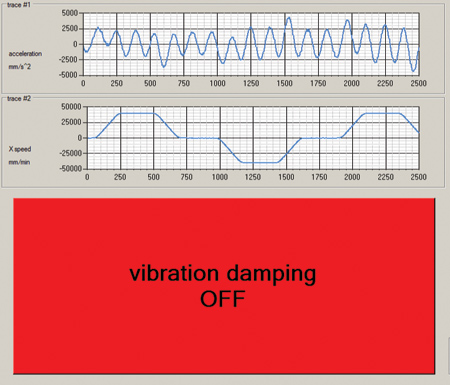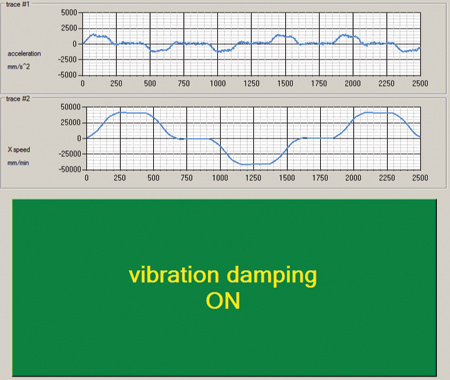
Vibration damping is OFF. Trace 2 shows the X-axis speed, while Trace 1 shows that the measured point on the machine is vibrating at its natural frequency (about 3 Hz).

Vibration damping is ON. Trace 2 shows the X-axis speed, while Trace 1 shows that the measured point on the machine is moving and that the acceleration is only the programmed rate (the natural frequency has been completely compensated).
NUM has launched an accelerometer-based active vibration control system for CNC machine tools. "Primarily designed to improve machining by virtually eliminating tool head vibration, the system further helps increase productivity by maximizing material removal rate (MRR) and can also provide valuable real-time feedback for predictive maintenance purposes," said a company spokesperson.
The system is available as a retrofittable option for any machine tool that uses NUM's MDLUX high performance digital servo drives, which form part of the company's Flexium+ CNC platform.
NUM's active vibration control system is designed to be a cost-effective solution that provides enhanced dynamic damping capabilities. "Most competitive accelerometers on the market are only capable of low frequency sampling rates and require additional signal conditioning electronics before they can be connected-usually via Fieldbus-to the CNC or PLC system," said the spokesperson. "Typically, acceleration data can only be retrieved once every 20 milliseconds, which is inadequate for vibration damping purposes on machine tools. The accelerometer in NUM's new system is sampled every 100 microseconds, which means that it can be used for closed loop control at bandwidths approaching several hundreds of Hertz."
The small flange-mounting accelerometer transducer can easily be attached to the machine's tool head and has a sensitivity of 0.02 g (1.96 m/sec/sec), with a measurement range of +/-2 g (+/-19.6 m/sec/sec). The transducer connects directly to the digital servo drive, obviating the need for any additional signal conditioning circuitry.
The active vibration control system utilizes the drive embedded macros (DEM-X) option that is available on NUM's MDLUX high performance digital servo drives. This option enables real-time macros to be embedded within the drive in order to manipulate its regulation algorithms. The output signal from the accelerometer transducer can thus be used to directly influence the behavior of the speed servo control loop. All MDLUX servo drive modules use advanced DSP control techniques to maximize the CNC kernel-to-drive servo bus speed, and feature high loop bandwidths and special acceleration algorithms for enhanced speed and positioning accuracy.
"One of the most interesting applications of NUM's new active vibration control system concerns Tool Center Point (TCP) vibration due to the various vibration modes of a machine tool's mechanical structure," said the spokesperson. "Until now, even if the machine is equipped with a high resolution encoder (integrated in the servo motor) it has been impossible to damp the TCP vibration, simply because it is not measured. Although complex system modeling and state-space control could possibly provide some effective results, the complexity is very high and the compensation robustness is quite weak. For example, in the case of a small parameter change, such as inertia, the effect of the compensation would be lost entirely."
The spokesperson continued, "However, by using NUM's new active vibration control system to measure and dynamically alter the TCP acceleration in each of the main X-, Y- and Z-axis directions, it is now possible to damp the vibration very accurately. Using this approach, tool head vibration can effectively be eliminated, significantly reducing tool wear and maximizing the MRR of the machining process."
All acceleration data is processed within the drive in the digital domain, which means that it can be cyclically transmitted to the Flexium+ NCK and stored in the NCK buffer. The data can then be uploaded to the Windows operating system for further evaluation, or for use with NUM's process monitoring software. It is especially useful for preventive maintenance applications, where it can provide early indication of potential machine problems before they become expensive repair tasks. Typically, these include detecting spindle vibration caused by bearing problems, detecting the onset of performance deterioration such as increased friction or backlash, and detecting excessive tool wear or breakage.
For more information contact:
Steve Schilling
NUM Corporation
603 East Diehl Road, Suite 115
Naperville, IL 60563
630-505-7722
sales.us@num.com
www.num.com